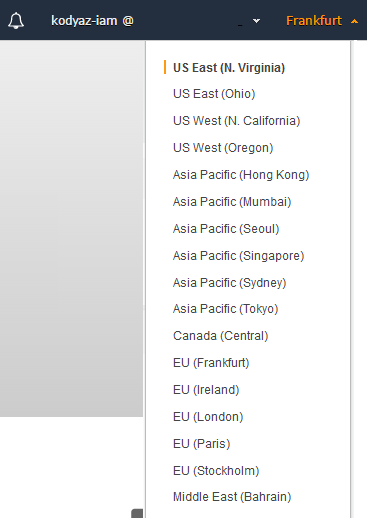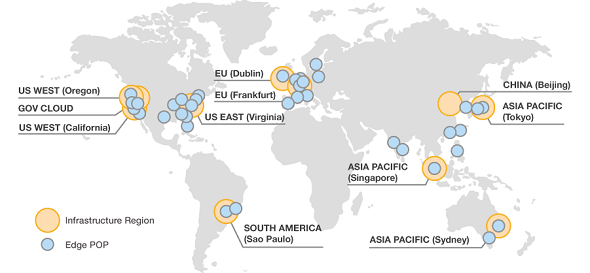AWS Region Names and Codes for Programmatic Access
Amazon Web Services AWS users and developers are familiar with Regions in AWS global infrastructure. For example, Frankfurt region is one of the many available AWS regions. But if you connect to AWS services programmatically using AWS SDK or via CLI Command Line Interface, you need more than the region name. That is the region code which is one of the components of the AWS service endpoint, part of the service URL address.
When AWS developers sign in to AWS Console using the root account or IAM user, they can see the list of all available regions on the top-right corner of the sceen.
Of course, here the region names are listed in the language of sign-in user for readability.

As I mentioned, if the Amazon Web Services developer doesn't use the GUI (Graphical User Interface) of the AWS Console, he or she will require to use the AWS Region Code either in the AWS SDK codes or in the Command Line Interface CLI tool.
So what is the region names and corresponding region codes mapping?
Here are the AWS Region name and codes in alphabetical order including the most recent launched AWS regions in new geographic areas:
| Region Name | Region Code | |
| Bahrain | Middle East (Bahrain) | me-south-1 |
| Beijing | China (Beijing) | cn-north-1 |
| Canada | Canada (Central) | ca-central-1 |
| Cape Town | Africa (Cape Town) | af-south-1 |
| Frankfurt | Europe (Frankfurt) | eu-central-1 |
| Hong Kong | Asia Pacific (Hong Kong) | ap-east-1 |
| Hyderabad | Asia Pacific (Hyderabad) | ap-south-2 |
| Ireland | Europe (Ireland) | eu-west-1 |
| Jakarta | Asia Pacific (Jakarta) | ap-southeast-3 |
| London | Europe (London) | eu-west-2 |
| Melbourne | Asia Pacific (Melbourne) | ap-southeast-4 |
| Milan | Europe (Milan) | eu-south-1 |
| Mumbai | Asia Pacific (Mumbai) | ap-south-1 |
| Ningxia | China (Ningxia) | cn-northwest-1 |
| N. California | US West (N. California) | us-west-1 |
| N. Virginia | US East (N. Virginia) | us-east-1 |
| Ohio | US East (Ohio) | us-east-2 |
| Oregon | US West (Oregon) | us-west-2 |
| Osaka | Asia Pacific (Osaka-Local) | ap-northeast-3 |
| Paris | Europe (Paris) | eu-west-3 |
| São Paulo | South America (São Paulo) | sa-east-1 |
| Seoul | Asia Pacific (Seoul) | ap-northeast-2 |
| Singapore | Asia Pacific (Singapore) | ap-southeast-1 |
| Spain | Europe (Spain) | eu-south-2 |
| Stockholm | Europe (Stockholm) | eu-north-1 |
| Sydney | Asia Pacific (Sydney) | ap-southeast-2 |
| Tokyo | Asia Pacific (Tokyo) | ap-northeast-1 |
| UAE | Middle East (UAE) | me-central-1 |
| US-East | AWS GovCloud (US-East) | us-gov-east-1 |
| US-West | AWS GovCloud (US-West) | us-gov-west-1 |
| Zurich | Europe (Zurich) | eu-central-2 |
As I mentioned for a successfull programmatic access to Amazon Web Services, AWS developer should correctly provide the region code in his or her AWS developments. Following image is showing AWS regions on a World map to understand the coverage of Amazon AWS services.

And below image is showing edge locations which are used to minimize content delivery latency on World map including a previous list of AWS regions

For Amazon reference document on the list of regions and endpoints, please refer to official website AWS Documentation
